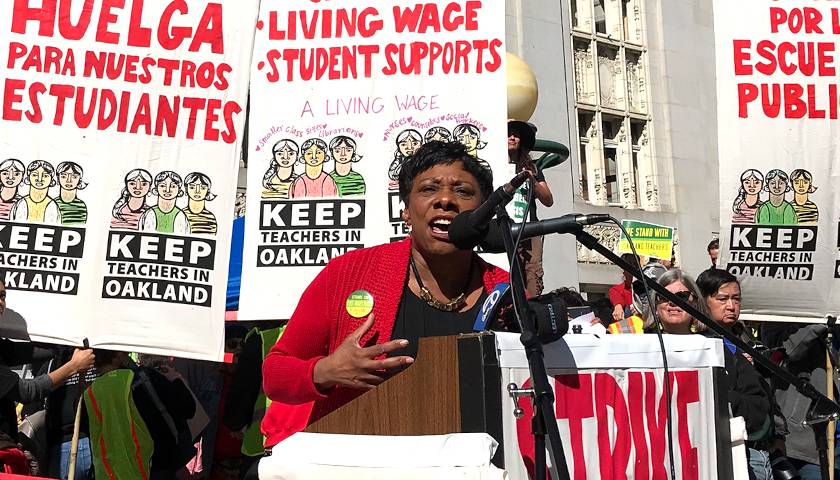by Maya MacGuineas
Our debt is too large. Inflation is too high. We rarely pass a budget anymore — this year neither Budget Committee even bothered to come up with one. This is how great nations become weakened nations, and with all the threats on the world stage, it is urgent we make a change now.
What we need is a budget that changes our fiscal trajectory away from one where the debt is growing faster than the economy, to one where it is stabilized and then gradually brought down.
We also need our political leaders to take the initiative to confront the hard choices inherent in budgeting (as opposed to the free lunch nonsense many of them have been peddling for years) and be willing to compromise where needed to get the job done.
Instead, they seem to be contemplating an absolutely reckless year-end deal where they trade debt-financed tax cuts for debt-financed spending increases and blow up the national debt even more.
 So it appears they need a little nudge. First, we should ask all our leaders to agree to no new debt for the rest of 2022 — literally only a few more weeks. Baby steps.
So it appears they need a little nudge. First, we should ask all our leaders to agree to no new debt for the rest of 2022 — literally only a few more weeks. Baby steps.
Second, they need to adopt a plan with enough savings to keep the debt from hitting and exceeding the highest level as a share of the economy in our nation’s history, which is on track to happen this decade. We have developed a blueprint to get that discussion going.
The Committee for a Responsible Federal Budget’s Fiscal Blueprint would save $7 trillion over the next decade — enough to keep the debt just below 100% of GDP. It also achieves a number of central principles including securing major trust funds, promoting long-term economic growth and supporting fairness and efficiency throughout the tax code and budget.
We suggest a combination of revenue and spending changes that include lowering health care costs, reforming the tax code, limiting discretionary spending, supporting affordable energy and infrastructure, enacting pro-growth Social Security reform and putting in place other reforms that would improve federal policy.
Roughly 40% of the deficit reduction would come from revenue increases and 60% from spending cuts, with many of the spending and revenue options having already been proposed by Democratic and Republican policymakers.
Specifically, we offer policies that would help curtail mandatory spending and raise sufficient revenue to fund our priorities. For example, reforming Medicare provider payments, reining in excesses of Medicare Advantage plans and redesigning Medicare benefits and premiums should be top priorities in bringing down health care costs.
With Social Security, increasing the retirement ages alongside low-income protections and phasing in a more progressive benefit formula are crucial to ensuring the program’s long-term solvency while promoting economic growth.
Improving the tax structure is also important, so we offer options like a deficit reduction surtax and eliminating the employer-side payroll tax in favor of a broader compensation tax as ways we can raise revenue efficiently.
Finally, a wide range of other policy proposals are included in the plan as well, from phasing in a carbon tax to using a more accurate measure of inflation for calculating inflation-indexed parameters in the budget.
Combined with caps on discretionary spending, these policies total $6 trillion in specific savings, with an additional $1 trillion coming from reduced interest payments on the national debt.
Importantly, reducing federal debt will also help ease today’s very high inflation. While the Federal Reserve is formally tasked with the responsibility of controlling inflation, reeling in deficits would assist in reducing inflationary pressures today and in the future. Without fiscal responsibility from Congress and the President, the Federal Reserve is forced to pursue more aggressive rate hikes that increase federal interest costs, discourage investment, and create a recessionary environment.
Our blueprint — in addition to stabilizing debt and reducing inflationary pressures — would represent a substantial step forward on many of policymakers’ existing goals while making the necessary tradeoffs to govern responsibly. While our blueprint isn’t the only solution, it offers policymakers a compromise plan that takes a measured approach at both reducing spending and raising the revenue to fund our government.
We don’t expect lawmakers to fully embrace the CRFB Fiscal Blueprint for all its details, but it offers a great place to start the serious conversation of fixing the enormous problem we find ourselves in.
Hopefully this will serve as encouragement for others to present their own plan — or, dare I say, present an actual budget — that offers their own solutions.
Divided government often lends itself to some of the best governing via compromise that we’ve experienced in modern times. There is a tremendous amount riding on Congress’s ability to act responsibly rather than recklessly in this moment.
– – –
Maya MacGuineas is president of the nonpartisan Committee for a Responsible Federal Budget.
The views and opinions expressed in this commentary are those of the author and do not reflect the official position of the Daily Caller News Foundation.




